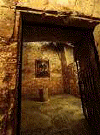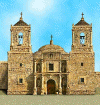|
A |
|
| The
church of San Antonio de Valero, better known as the Alamo, would
have looked something like this had it been completed according to plan.
The original design of the church has frequently been likened to that
of nearby Mission Concepción with a full three-level baroque
retable facade, flanking bell towers, and a central dome topping the
characteristic crusiform floorplan.
©2004, Alamo de Parras |
|
| MissionConcepción,
1886 Mission Concepción, near San Antonio, is thought to resemble the intended design of the Alamo chapel. | |
| José
Juan Sánchez Navarro, ca. 1835-36. Earliest known view of the Alamo. Western Americana Collection Beinecke Library, Yale University |
|
 |
At
left is the mission's supposed appearance in 1836. Notice the
absence of the two upper windows. Those were placed there by the U.S.
Army around 1850. The conjectural view is based on early period drawings and the one known photo of the Alamo taken before the U.S. Army reconstruction. ©2004, Alamo de Parras |
| Mary
Ann Adams Maverick, watercolor, ca. 1838 Earliest known post-battle view of the Alamo ruins. From Rena Maverick Green, Samuel Maverick, Texan, 1803-1870, 1952 |
|
 |
Thomas
Falconer, April 22, 1841 Watercolor sketch, inscribed "Entrance to Church, within the Alamo at Bexar, Texas..." Western Americana Collection, Beinecke Library, Yale University |
 |
William
Bollaert, 1843 Pencil sketch showing the south wall of low barracks (left), the church, and two small houses next to the Alamo. Edward E. Ayer Collection, the Newberry Library, Chicago |
|
|
Jacob
Edmund Blake-Sketch, 1845
National Archives |
 |
Edward
Everett, watercolor, 1847 View of the Alamo church. Amon Carter Museum, Fort Worth |
 |
Edward
Everett "Interior View of the Church of the Alamo," watercolor, 1847. Amon Carter Museum, Fort Worth |
| Sketch
by Seth Eastman, 1848
McNay Art Institute, San Antonio,
Texas. |
|
| Edward
Everett Sketch, 1848 Documentation of U.S. Army repairs for that year. National Archives |
|

|
Arthur
T. Lee, ca.1848 Watercolor view of Alamo ruins. In the background are several of the old Indian houses built along the outer west wall. Rochester Historical Society, Rochester, New York |
 |
Seth
Eastman, 1848-49 "Mexican houses in San Antonio, Texas. Part of the Alamo," from Seth Eastman Sketchbook, 1848-49, pencil on paper. |
 |
1849 Daguerrotype, Photographer
Unknown. Center for American History, University of Texas at Austin. |
| Hermann
Lungkwitz. 1850 Detail of lithograph. The Alamo chapel |
|

|
Lithograph
after Hermann Lungkwitz, ca. 1852 The growing city of San Antonio in 1852 surrounds the Alamo church, far right, seen from the rear with new Army roof and gable. |
| Alamo
buildings in use as Army supply depot, ca. 1850-1870.
The San Antonio Light Collection, UT Institute of Texan Cultures |
|
 |
Gleason's
Pictorial Drawing-Room Companion, 1854. Picture depicting he Alamo as a stylish promenade ground. DRT Library at the Alamo, San Antonio, TX |
|
|
Grenet's
Alamo Store 1880-82 Hugo Grenet's Alamo store located in the converted convent building, seen here in an etching made between 1880 and 1882 and reprinted in Adina de Zavala's History and Legends of the Alamo, 1917. From Adina De Zavala, History and Legends of the Alamo, 1917 |
 |
Jean
Louis Theodore Gentilz, ca. 1885 "Fall of the Alamo," oil painting. Destroyed ca. 1906. Courtesy DRT Library at the Alamo, San Antonio |
 |
The Alamo
and Hugo and Schmeltzer Building, ca. 1890.
|
 |
John
A. Beckmann,Sketch, ca. 1895 Conjectural view of the Alamo ruins in 1845. Issued on a souvenir photograph by J. Eckerskorn of San Antonio. Note the presence of the two upper windows in the chapel. These did not exist until the U.S. Army's restoration in the early 1850's. |
|
|
Anonymous,
"Alamo Church" , 19th Century Anonymous painting, probably nineteenth century, of the "Alamo Church." A stucco coating is clearly visible on the walls. DRT Library at the Alamo, San Antonio |
| Alamo
Plaza, ca. 1900, showing one of the nearby saloons.
DRT Library at the Alamo, San Antonio |
|
 |
The
Alamo. Souvenir of the Picturesque Alamo City, 1907 |

|
The Alamo. Souvenir Postcard, 1908 Tinted Black & White Photo Collection of Randell Tarín |

|
The Alamo.
Souvenir Postcard, ca. 1900 |
 |
The Alamo
Plaza Souvenir Postcard, ca. 1900 |
 |
Alamo
Plaza Souvenir Postcard, ca. 1900 |

|
Post
card (ca. 1910 )showing a rare view of the Church's Interior.
Notice the ceiling. Compare it to the image below.
Private Collection |


|
Interior Views
of the Alamo Shrine. Photos by Bill Reaves © Texas Parks & Wildlife |

|
Robert Julian Onderdonk, ca. 1910-20
|

|
Rolla Taylor, ca. 1911
|
|
|
Alamo chapel and convent building in 1912, with Grenet's wooden arcades partially removed.
|
 |
Alamo grounds, ca. 1912-13, showing surviving convent walls. See:Too
Much Rain Cracks West Wall of Alamo Fort. |
|
|
Eugene O. Goldbeck, ca. 1919 Alamo Plaza
|

|
Alamo
grounds, 1937, showing demolition of neighboring buildings. San Antonio Light Collection, University of Texas Institute of Texan Cultures at San Antonio |

|
Andrew Jackson Houston , 1938
From Lenoir Hunt, Bluebonnets and Blood, 1938 |

|
Movie Set © 1960 United Artist. Used with permission. |
 |
The
Losoya Home Excavation of the Alamo's west wall in 1979-80, showing two-room residence of the family of Alamo defender José Toribio Losoya. Today, visitors to San Antonio can still see portions of this excavation. It's located at the top of the entrance stairway to the San Antonio Riverwalk directly across the street from the Alamo chapel. Center for Archaeological Research, UT San Antonio |
 |
This is the Alamo facade as it appears today. |




